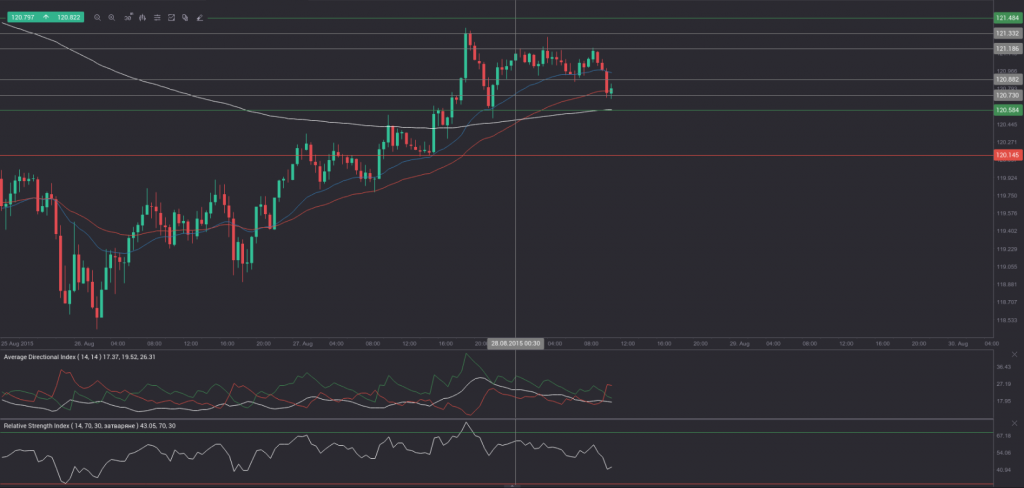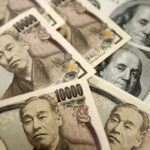Yesterday’s trade saw USD/JPY within the range of 119.77-121.39. The pair closed at 121.03, soaring 0.93% on a daily basis, or the most considerable daily gain since July 10th, when it appreciated 1.16%. The daily high has also been the highest level since August 24th, when the cross registered a high of 122.04.
At 7:49 GMT today USD/JPY was losing 0.10% for the day to trade at 120.91. The pair touched a daily low at 120.84 at 7:50 GMT.
Today the cross may be influenced by a number of macroeconomic reports as listed below.
Fundamentals
United States
Personal Income, Personal Spending
Personal spending in the United States probably rose for a third straight month in July, up 0.4%, according to market expectations, while personal income was probably up for a fourth consecutive month in July, increasing at a monthly rate of 0.4%. Spending rose 0.2% in June. Personal consumption expenditures (PCE) were up USD 25.9 billion, or 0.2%, in June.
At the same time, personal income increased 0.4% during the same month, while disposable personal income (DPI) rose USD 60.6 billion (or 0.5%). Private wages and salaries increased USD 16.0 billion in June, compared to a surge by USD 29.6 billion in May. Government wages and salaries went up by USD 2.3 billion, following a USD 2.4 billion increase in the preceding month.
Higher-than-expected rates of increase imply good employment conditions and, therefore, are dollar positive. The Bureau of Economic Analysis is to publish the official figures at 12:30 GMT.
Reuters/Michigan Consumer Sentiment Index – final reading
The monthly survey by Thomson Reuters and the University of Michigan may show that consumer confidence in the United States lowered for a second consecutive month in August. The final reading of the corresponding index, which usually comes out two weeks after the preliminary data, probably came in at 93.0, up from a preliminary value of 92.9, reported on August 14th. In July the gauge of confidence came in at a final reading of 93.1, down from a preliminary value of 93.3. The survey encompasses about 500 respondents throughout the country. The index is comprised by two major components, a gauge of current conditions and a gauge of expectations. The current conditions index is based on the answers to two standard questions, while the index of expectations is based on three standard questions. All five questions have an equal weight in determining the value of the overall index.
According to preliminary data, the sub-index of current economic conditions, which measures US consumers’ views of their personal finances, decreased to a reading of 107.1 in August from a final 107.2 in July. The sub-index of consumer expectations plunged to a flash reading of 83.8 in August, down from a final value of 84.1 in July.
In case the gauge of consumer sentiment showed a larger decrease than anticipated, this would have a moderate bearish effect on the US dollar. The final reading is due out at 14:00 GMT.
Bond Yield Spread
The yield on Japanese 2-year government bonds went as high as 0.015% on August 27th, or the highest level since July 15th (0.017%), after which it slid to 0.010% at the close to add 0.002 percentage point on a daily basis.
The yield on US 2-year government bonds climbed as high as 0.715% on August 27th, or the highest level since August 19th (0.738%), after which it fell to 0.700% at the close to add 2 basis points (0.02 percentage point) for the day. It has been a third consecutive trading day of gains.
The spread between 2-year US and 2-year Japanese bond yields, which reflects the flow of funds in a short term, widened to 0.690% on August 27th from 0.672% during the prior day. The August 27th yield spread has been the most notable one since August 18th, when the difference was 0.715%.
Meanwhile, the yield on Japans 10-year government bonds soared as high as 0.393% on August 27th, or the highest level since August 17th (0.400%), after which it slid to 0.375% at the close to remain unchanged compared to August 26th.
The yield on US 10-year government bonds climbed as high as 2.207% on August 27th, or the highest level since August 19th (2.230%), after which it slipped to 2.195% at the close to add 1.5 basis points (0.015 percentage point) on a daily basis, while marking a third consecutive day of gains.
The spread between 10-year US and 10-year Japanese bond yields widened to 1.820% on August 27th from 1.805% during the prior day. The August 27th yield difference has been the largest one since August 14th, when the spread was 1.821%.
Daily and Weekly Pivot Levels
By employing the Camarilla calculation method, the daily pivot levels for USD/JPY are presented as follows:
R1 – 121.18
R2 – 121.33
R3 (range resistance – green on the 30-minute chart) – 121.48
R4 (range breakout – red on the 30-minute chart) – 121.92
S1 – 120.88
S2 – 120.73
S3 (range support – green on the 30-minute chart) – 120.58
S4 (range breakout – red on the 30-minute chart) – 120.14
By using the traditional method of calculation, the weekly pivot levels for USD/JPY are presented as follows:
Central Pivot Point – 122.80
R1 – 123.81
R2 – 125.58
R3 – 126.59
S1 – 121.03
S2 – 120.02
S3 – 118.25






